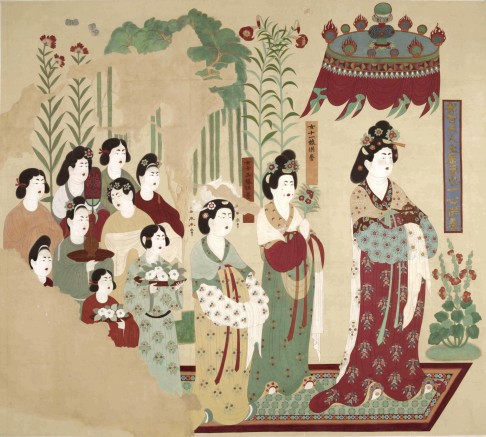Dunhuang exhibition reveals China's multicultural past
Religious and cultural relics from Dunhuang's ancient grottoes are on show at the Hong Kong Heritage Museum
They may not have achieved the global renown of the Great Wall and the Terracotta Warriors, but it could be argued that Dunhuang's ancient grottoes are China's most important cultural relics.
These caves, hewn by hand out of cliffs that descend into the great Gobi Desert, chart the development of Chinese art for a thousand, uninterrupted years. They are also depositaries of a multicultural past that adds fluidity and colour to China's national identity.
Fourth-century devotees started carving meditation cells in the cliffs above the Dachuan River after a Buddhist monk named Le Zun had a vision at nearby San Weishan. Dunhuang's reputation as a sacred site grew and master craftsmen, both Chinese and from Central Asia, venerated the caves and added frescoes and statues until the Yuan dynasty. Silk Road travellers left Persian coins and Bibles written in the Syriac script, a close cousin of the Aramaic tongue of Jesus. Monks, Buddhist and Taoist were living in this remote spot until the 1930s.
All this history can be a bit overwhelming. The great cultural essayist Yu Qiuyu certainly thought that about the Mogao caves - the area with the highest concentration of these ancient cells. In , he said a visitor would be bowled over by an excess of cultural awareness and crushed into insignificance by the giant hands of great artists.
Yu went there in the 1980s. Today's visitors need to brace themselves for another reason. Fierce crowd control means that everyone is whisked through the few accessible caves by brusque official guides swinging their torches from one bodhisattva to another, and giving highly condensed versions of the great Jataka tales as told by centuries-old murals.

Tourists peer intensely in the dark and try to absorb as much as they can before their allotted minutes are up. Too soon they are herded back into the blinding desert sun to make way for the next group. But many still consider it one of the most memorable of cultural experiences.
But the caves have suffered years of neglect and the Dunhuang Academy, manager of the site, is trying to curb visitor numbers so as to preserve the fragile artwork.
Officials in the early 20th century were so ignorant of the value of this legacy that a resident Taoist monk in Mogao, who uncovered great hoards of artifacts, was able to sell them for a pittance to Western and Japanese explorers.
Many frescoes, such as the one in the less-visited Western Thousand Buddha Caves area, were damaged by graffiti before doors and padlocks were introduced.
Time and visitor number will continue to take their toll - which is why the Dunhuang Academy and its international partners have been pouring their efforts into digitisation projects and travelling exhibitions such as the one that opened at the Hong Kong Heritage Museum on Friday.
It will feature more than 200 genuine artifacts that have been discovered in the caves, including the Book of Psalms in Syriac and the only surviving copy of Essential Mantras in the Tanguy script.

Visitors will see replicas of three caves that were decorated during different periods: Northern Liang (around AD420-439), Early Tang (AD668-704) and the period just before the Yuan dynasty when the Mongols occupied Dunhuang from AD1227.
Most Dunhuang caves have a central altar featuring a large Buddha statue, flanked by standing bodhisattvas. Around them are murals that tell the tales of the Buddha's three lives and, sometimes, portraits of pious-looking donors who paid for the decoration of that particular cave.
The artistic styles on show cross the great expanse of 1,000 years of Chinese art and also show how foreign painting styles came into the country.
Among the replicas of murals in this exhibition is the . It was painted in the Northern Wei (AD386-534) period, when the Tuoba people united northern China after a period that is now usually called, in a rather Han-centric way, the "Sixteen Kingdoms of the Five Barbarian Tribes".
The Tuobas absorbed Han culture and introduced their own that became part of Chinese everyday lives. Meanwhile, out in the western Oasis of Dunhuang, Central Asian artists were painting their interpretations of Buddhist tales on the cave walls.
"The featured the Central Asian hunran method - a way of creating differing levels of depth by using one shade of colour - that became widely adopted by Chinese artists," says Lou Jie, director of the exhibition centre at the Dunhuang Academy.
"The characters in the mural are also seen wearing a different style of clothing. It's likely that it was executed by artists from the west of China," says Lou.
Lou adds that replicas such as one included in the show in Hong Kong are a more useful reference than the damaged original.
The copyist of was the late Duan Wenjie. The director of the Dunhuang Academy, he moved to Mogao in 1945 after he became fascinated by the copies of cave murals made by Zhang Daqian, the painter.
Duan copied this image on the south wall of Mogao Cave 130 in the 1950s, when details of Lady Wang could still be seen. Today, much of the wall surface has crumbled away.
The exhibition is sponsored by the Hong Kong Jockey Club and has an audio dramatisation of mural scenes by the Hong Kong Repertory Theatre in Putonghua and English.
It's nothing like being there, but there is a lot to be said for being able to gaze at these enchanting images from the past at your leisure.
Dunhuang - Untold Tales, Untold Riches is at the Hong Kong Heritage Museum, Sha TIn until Mar 16

